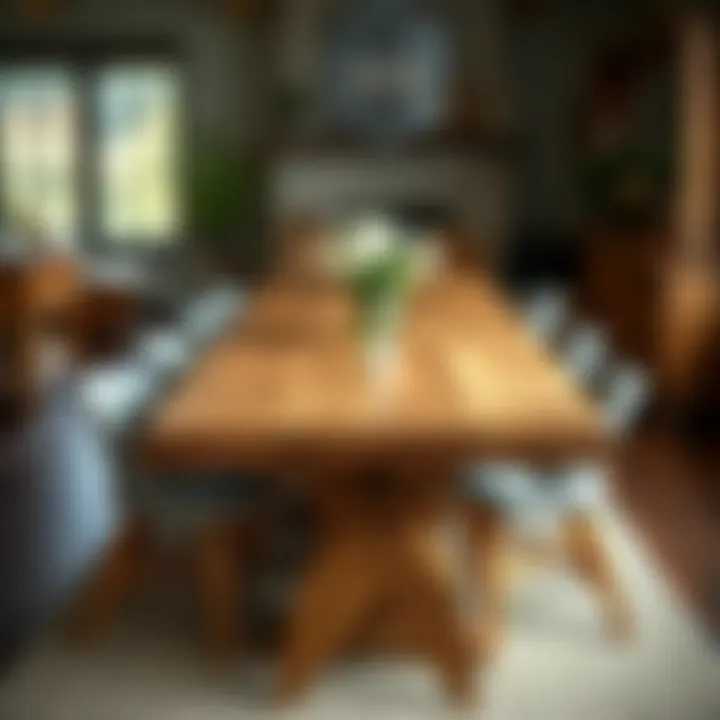Versatile Four-Legged Wood Dining Tables: Design & Functionality


Intro
Four-legged wood dining tables have long been the centerpiece of social gatherings. They are not just pieces of furniture; they embody the essence of family dinners, festive celebrations, and quiet morning coffees. When it comes to functionality and aesthetic appeal, these tables claim a versatile spot in many homes. Explore the elegant construction, timeless designs, and functional benefits as you navigate through the intricacies of four-legged wood dining tables.
This article will guide you through design trends that reflect the latest in furniture style, helping you choose what’s best for your space. In addition, practical buying guides will pave the way for informed decisions, tailored to fit individual needs and preferences.
Let's dive into the world of craftsmanship, material selection, and the impact a well-chosen dining table has on the overall ambiance of your dining area, allowing you to find that unique balance between form and function.
Intro to Four-Leg Wood Dining Tables
When considering the heart of a home, it's often the dining area that springs to mind. At the center of this space typically stands the four-leg wood dining table, a piece that embodies both form and function. These tables aren't merely surfaces upon which meals are served; they are the setting for memories, gatherings, and conversations that weave the fabric of family life.
The allure of four-leg wood dining tables lies in their versatility. Whether you lean towards a modern or rustic aesthetic, these tables can harmonize with various design styles, making them a staple in homes across the globe. It's easy to see why they have earned a spot in both casual kitchens and formal dining rooms.
In this article, we will delve into various aspects of four-leg wood dining tables, focusing on their design, material choices, and construction. Understanding the importance of this furniture type is essential whether you are a homeowner, a designer, or an enthusiast. Below are some key advantages that underscore their significance:
- Stability and Support: The four-leg structure provides a solid foundation, ensuring that the table can withstand the rigors of daily use.
- Space-Efficiency: These tables often fit well into diverse room configurations, making them a practical option for both spacious and snug dining areas.
- Timeless Aesthetics: Wood has a natural warmth and appeal that never goes out of style, allowing these tables to remain relevant across eras.
- Cultural Significance: The design and use of dining tables often reflect cultural practices surrounding meals and hospitality, making them significant beyond mere functionality.
As we explore the various styles, materials, and construction methods of four-leg wood dining tables, it will become evident that a careful selection can lead to a level of satisfaction that enhances one’s dining experience. So, let’s take a closer look at the historical context of dining tables to understand their evolution and the cultural variations that shape our choices today.
The Historical Context of Dining Tables
Dining tables have long been central to our social lives, acting as more than just a piece of furniture. They represent a gathering space where families and friends come together for shared meals and conversations. To appreciate the versatility of four-leg wood dining tables, it helps to dive deep into their historical significance and evolution through different cultures and eras.
The Evolution of Dining Furniture
The journey of dining tables dates back thousands of years, where early versions were often rudimentary, made from stone or basic wood constructions. In ancient Roman times, for example, tables were flat surfaces supported by a few legs, used primarily for serving food rather than sitting down for a meal. Over the centuries, the designs evolved significantly. By the Middle Ages, dining furniture became more refined, with the introduction of trestle tables that offered a more comfortable eating experience for larger groups. Four-leg configurations gained popularity during the Renaissance, giving stability and a classic aesthetic to the dining room. The use of wood, particularly fine varieties like oak and walnut, reflected wealth and status, while the craftsmanship ensured durability. Each period introduced distinct styles, like the ornate carvings of the Baroque or the minimalism of the Shaker design, ultimately leading to today’s diverse options.
Cultural Variations in Dining Table Design
Across cultures, dining tables have adapted to local customs and societal norms. In Japan, for instance, the traditional chabudai is lower to the ground, emphasizing sitting on tatami mats, while European tables may be grand and ornate, mirroring social hierarchy and opulence. Similarly, in Scandinavian countries, function meets form with simple, functional designs made from light woods that reflect the region's aesthetic sensibilities.
In many African cultures, communal dining tables serve as a gathering point, underscoring the importance of community and shared experiences. Even within the same country, regional variations can cause dining table styles to shift, influenced by local materials and craftsmanship styles.
"Understanding the historical and cultural significance of dining tables adds depth to our appreciation of these furnishings in modern times."
The context in which dining tables have arisen shapes our understanding of their practical use and symbolic meanings. Today, as we decorate our homes, considering these backgrounds can inform our choices, leading to selections that resonate personally while also honoring the art of craftsmanship and social history.
Understanding Design Styles
When it comes to four-leg wood dining tables, the importance of design styles cannot be overstated. These styles dictate not only the table's aesthetic but also its functionality within a home. A well-chosen dining table can serve as the centerpiece of a room. It shapes the atmosphere of daily meals, gatherings, and celebrations. Hence, understanding design styles helps homeowners, designers, and retail enthusiasts choose the right table that resonates with their personal style and complements their living space.
Modern Aesthetics in Wooden Tables
Modern aesthetics primarily focus on clean lines, minimalism, and innovative use of materials. Wooden tables that align with this style often feature sleek surfaces, asymmetrical forms, and a combination of wood with metals or glass. For instance, a table with a smooth walnut surface and stainless-steel legs exemplifies contemporary design, catering to a clientele that appreciates both functionality and an eye-catching appearance.
Moreover, the color palette tends to lean towards neutral tones—greys, whites, and natural wood finishes. This choice not only enhances the beauty of the wood itself, but it also makes these tables flexible in various settings.
Some benefits of modern design styles in wooden tables include:
- Versatility: They match effortlessly with different decor types.
- Space maximization: Many designs incorporate expandable features, which are great for small apartments.
- Ease of cleaning: The minimalist approach often leads to fewer decorative elements that can trap dirt and dust.
Rustic Charm of Traditional Designs
On the flip side, rustic dining tables bring warmth and a sense of nostalgia into a home. Characterized by their robust structure and natural finishes, these tables often showcase the wood's imperfections and unique grain patterns. They might include features like turned legs and distressed paint, offering a sense of history and character that modern tables often lack.
In many cases, these wooden tables are made from reclaimed wood, which not only emphasizes their rustic appeal but also speaks to a deeper commitment to sustainability. The tactile nature of these surfaces invites touch, fostering connection and memories of home-cooked meals and family gatherings.
Key characteristics of rustic wooden dining tables include:
- Durability: Built to withstand wear and tear, making them family-friendly.
- Aesthetic appeal: Exquisite details and craftsmanship highlight the beauty of nature.
- Environmentally friendly options: Many buyers today prefer sustainable choices, reinforcing the connection between home decor and ecological responsibility.
Eclectic Combinations in Contemporary Spaces
The eclectic style merges various influences, creating a rich tapestry of textures, colors, and forms. A dining table in an eclectic home might feature a traditional wooden top paired with chairs of differing styles—some modern, some vintage—creating a lively contrast. This style is ideal for those who wish to express their individuality through their space.
One popular approach within this category is to choose a wooden table and then surround it with chairs that have bold fabrics or striking designs. This combination invites conversation and fosters an inclusive environment where guests feel relaxed and at ease.
For homeowners embracing this style, a few things to consider are:
- Cohesion: Make sure the elements work together, even if they are different.
- Balance: While mixing styles, keep an eye on color harmony and scale.
- Functionality: Ensure each piece serves a purpose without cluttering the space.


Embracing various designs provides depth and uniqueness to a home, allowing for personal expression.
Materials: The Heart of Wooden Dining Tables
Dining tables are more than just a place to eat; they are the hub of family gatherings, conversations, and celebrations. Thus, the materials used in crafting these important pieces of furniture play a vital role in their functionality and appeal. Understanding the right materials ensures not just aesthetic satisfaction but also durability and usability. In the context of wooden dining tables, let's delve into the types of wood utilized, the balance of durability and style, as well as the significance of sustainability in material choices.
Types of Wood Suitable for Dining Tables
Choosing the right type of wood is fundamental when selecting a dining table. Each wood type brings its unique character and features that may fit different styles and settings. Some of the commonly favored choices include:
- Oak: Renowned for its strength and longevity, oak has a coarse grain, offering a classic yet timeless appeal.
- Maple: This hardwood is lighter in color and exhibits fine, straight grains, making it ideal for modern designs, reflecting simplicity and elegance.
- Walnut: Known for its rich, dark hues, walnut combines luxury with sturdiness, making it a fine choice for high-end dining experiences.
- Pine: This softer wood is easily shaped and is often associated with rustic or farmhouse styles, lending a warm and inviting feel to spaces.
Different types of wood allow for a range of aesthetic and practical applications. Selecting the right one can complement existing decor and serve various functional needs.
Balancing Durability and Style
When it comes to dining tables, there’s always a quest to find harmony between durability and style. A beautifully crafted table loses its charm if it can’t withstand daily use. This is where the knowledge of wood properties comes into play.
For instance, while softer woods like pine can offer stunning designs, they may not hold up as well to heavy usage or scratches. Conversely, dense woods like maple or oak can last for decades, but might miss the mark in elegance compared to more refined options such as walnut. Therefore, when considering a dining table, think about your dining habits. If you have children or frequently host gatherings, choosing a harder wood with a protective finish may prove beneficial in terms of longevity.
Additionally, various design techniques, such as incorporating protective coatings, can enhance the durability without sacrificing visual allure. This level of thought ensures a table isn’t just a piece of furniture but a lasting investment that provides emotional and functional value.
Sustainable Wood Options
In today’s environmentally-conscious world, sustainability plays a growing role in the selection of materials for furniture. It’s vital to understand that not all wood is created equal. The use of sustainably sourced wood helps mitigate adverse environmental impacts.
Many manufacturers now offer FSC-certified (Forest Stewardship Council) options, which guarantee that the wood has been sourced from responsibly managed forests. Additionally, several companies are also turning to reclaimed wood, giving a second life to materials while reducing deforestation. Using reclaimed wood not only supports sustainability, but it also often brings a unique character, telling its own story through its weathered appearance.
Moreover, looking for options that possess recycled content can further enhance your dining table’s role in promoting eco-friendliness. By making more informed choices, you not only select a dining table that meets your aesthetic needs but also contribute to preserving the environment for future generations.
Sustainability is not just a trend; it’s a necessity. Opting for sustainable materials reflects a commitment to the planet and enhances the charm of your living space.
Ultimately, understanding materials informs smarter choices, leading to dining tables with aesthetics, durability, and sustainability intertwined. An informed decision now can make your dining experience more fulfilling and impactful.
Construction Techniques
When it comes to four-leg wood dining tables, the construction techniques employed are crucial to their quality, durability, and aesthetic appeal. The way these tables are built not only affects their structural integrity but also contributes to the overall look and feel of a dining area. Therefore, understanding construction methods can help homeowners and enthusiasts make informed decisions when selecting a table that suits their needs and style.
Joinery Methods in Furniture Making
Joinery is a fundamental aspect of furniture crafting, particularly for wooden dining tables. Essentially, it refers to the methods used to connect different pieces of wood, employing various strategies that influence the table’s longevity and stability.
Some widely recognized joinery methods include:
- Mortise and Tenon: This classic method encourages a strong connection by inserting a tenon from one piece of wood into a matching mortise in another. It’s renowned for holding up well over time, making it a go-to choice for durable tables.
- Dowel Joinery: Dowel joints use wooden pins to reinforce connections between table components. While it demands precision during assembly, the result is often a clean aesthetic that appeals to many.
- Pocket Hole Joinery: This technique involves drilling angled holes to join wood pieces together. It’s popular for its simplicity and effectiveness, especially for DIY enthusiasts looking for an easy way to achieve strong joints.
The importance of choosing the right joinery method can't be overlooked. Each technique presents its unique pros and cons. For instance, mortise and tenon joints may take longer to produce but they typically ensure a longer life for the table, while pocket hole joinery provides a quicker solution that is perfectly adequate for less intensive use. It ultimately boils down to how often the dining table would be used and the overall style desired.
Finishing Touches: Stains and Sealants
Once the construction is complete, applying the right finishes is vital to protect and enhance a wooden dining table. Stains and sealants not only enrich the wood’s natural aesthetics but also play a significant role in maintaining the integrity of the material.
- Stains: They help highlight the wood grain and add character. They come in a variety of shades, enabling homeowners to either complement or contrast with existing decor. For instance, a deep walnut stain may add warmth to a modern dining room, while a light oak stain could brighten a rustic farmhouse setting.
- Sealants: These are essential for protecting the surface from scratches, spills, and humidity. Oil-based sealants typically offer a durable finish, ideal for dining tables that see a lot of use. Water-based options, however, are faster drying and less odorous, making them suitable for indoor use.
"Regular maintenance and reapplication of sealants can greatly prolong the life of your dining table, keeping it as lovely as the day you brought it home."
Selecting appropriate finishes is not merely about aesthetics; it’s about preserving the table for years to come. A good finish can defend against everyday wear and tear, while also making clean-up a breeze, especially in homes with children or frequent diners.
In summary, the construction techniques that go into making four-leg wood dining tables are what elevate these pieces from simple wooden structures to cherished centerpieces of home life. Understanding joinery and finishing methods will guide you toward making choices that enhance both functionality and style in your dining space.
Practical Benefits of 4-Leg Designs
When it comes to choosing a dining table, the practical benefits of a four-leg design can't be overlooked. These tables offer remarkable stability, support, and versatility, making them ideal for various dining environments. Understanding their advantages is crucial, not only for homeowners but also for designers and retailers who seek to enhance the dining experience. This section outlines the key benefits that four-leg wood dining tables bring to the table—literally and figuratively.
Stability and Support
One of the standout features of four-leg wood dining tables is their stability. The four-point support system naturally distributes weight evenly, minimizing wobbling that can plague other designs. Imagine trying to enjoy a meal at a table that rocks like a boat. Quite the nuisance, right? With a four-legged structure, you can rest assured that your meals can be enjoyed without interruptions.
Additionally, the robust construction of wooden materials adds yet another layer of durability. Unlike tables constructed with less sturdy materials, quality wood—like oak or walnut—ensures that the table not only bears heavy dishes but also withstands the test of time.


- Enhanced weight distribution allows for carefree dining.
- Reduction in movement decreases the risk of spills, maintaining cleanliness.
- Timely repairs can often be carried out, extending the life of your investment.
Dining Table Size and Shape Considerations
When it comes to selecting a wooden dining table, size and shape play crucial roles. These factors not only set the tone for the room but also dictate how functional and comfortable the dining space will be. Think about it: a table that’s too large can overwhelm a small room, while one that’s too small might not accommodate family or guests comfortably. Evaluating the right size means taking a few key considerations into account.
Determining the Right Size for Your Space
Choosing the right size involves more than just measuring the table. It’s about harmonizing the table with the room’s dimensions and the existing furniture.
- Room Dimensions: First, measure the area where you plan to place the table. Generally, you want to ensure there’s at least 3 feet of clearance around the table for movement.
- Table Height: Most dining tables are around 28 to 30 inches in height. Adjust your chair height accordingly to maintain a comfortable posture.
- Seating Capacity: As a rule of thumb, allow about 24 inches of space per person at the table’s edge. This ensures everyone can eat with comfort.
- Table Footprint: Consider how the shape of the table affects the room’s flow. Round tables can promote conversation and fit well in corners, while rectangular tables maximize space in long rooms.
Taking these points into consideration can help you select a dining table that fits just right, neither turning the room into a cramped corner nor leaving it looking bare.
Common Shapes and Their Applications
The shape of a dining table isn’t merely an aesthetic choice; it has functional implications as well. Different shapes suit various settings and purposes:
- Rectangular Tables: These are popular for larger gatherings and generally seat more people. They offer a great fit for extending seating arrangements.
- Round Tables: Ideal for smaller spaces, these tables foster intimacy and conversation. They’re great for casual meals with friends or family.
- Square Tables: Perfect for small groups, square tables can create an engaging environment. They fit nicely in corners or small dining areas where a slightly larger footprint can feel cramped.
- Oval Tables: Combining features of round and rectangular tables, oval tables can soften sharp corners in a dining space.
"Choosing the right shape and size of your dining table can transform any meal into a memorable experience, making every gathering a bit more special."
In summary, size and shape are integral to the functionality and aesthetic appeal of four-leg wooden dining tables. Prioritizing these elements not only enhances the dining experience but also harmonizes the space, making sure it caters to both guests and daily use alike.
Choosing the Right Dining Table
Selecting the appropriate dining table is about more than just picking a piece of furniture; it’s about defining the heart of your home. This article emphasizes the critical factors involved in choosing a dining table that not only suits your practical needs but also reflects your personal style. From family gatherings to intimate dinners, the dining table serves as a gathering point, a space for connection, and a true expression of design.
When faced with the myriad options of four-legged wood dining tables, there are key elements to think about. The choice of shape, size, and style can have a profound impact on how a space feels and functions. Each table serves a purpose, and consideration of the dynamics of your household can guide you to the best option.
Factors to Consider in Selection
- Space Availability: Measure the area you have designated for the table. Ensure there's room around it for movement and chairs. A good rule of thumb is to allow at least 36 inches of clearance on all sides.
- Table Shape: Different shapes cater to various needs. Round tables, for instance, are ideal for smaller spaces and encourage conversation, while rectangular tables are great for larger gatherings.
- Number of Seats: Consider how many people you usually entertain. A standard dining table ranges from a four-person setup to ones that can seat ten or more.
- Style Consistency: Keep in mind the aesthetic of your home. Your chosen table should harmonize with your existing decor, whether it's contemporary, traditional, or eclectic.
- Durability Requirements: Think about your daily use. If you have kids or tend to host frequent parties, go for sturdier materials that can withstand wear and tear.
"A well-selected table goes beyond aesthetics; it creates an environment where cherished memories are made."
Matching Style with Decor
Finding a dining table that aligns with your home’s style can be a delightful yet challenging task. Below are considerations to ensure that your dining table enhances rather than clashes with existing decor:
- Transitional Spaces: If your home reflects a mix of modern and traditional styles, consider a table that serves as a bridge. For example, a reclaimed wood table can add rustic charm without compromising contemporary aesthetics.
- Color Coordination: Think about how the color of your table will interact with your walls and other furniture. Dark woods can bring a sense of elegance, while lighter finishes may lend an air of airiness and openness.
- Design Elements: Identify if there are recurring elements in your home, such as curved edges or straight lines, and try to find a table that resonates with those features. A table with ornate details might clash in a minimalist environment.
- Artistic Balance: Consider incorporating artful pieces into the décor that complement the table. A splendid vase or unique center piece can elevate the entire dining experience, drawing the eye without overwhelming the space.
Maintenance and Care for Wooden Tables
Taking care of your wooden dining table is crucial if you want it to endure the test of time. Regular maintenance doesn’t just keep it looking shiny; it also protects the wood from potential damage that can occur over the years. Proper care ensures that you maintain the aesthetic appeal and functionality of the table, which can be a central piece in your dining area.
From spills to scratches, a wooden table can face a lot. But with the right maintenance techniques, you can easily keep these woes at bay. Beyond preserving beauty, it’s about being practical – no one wants a wobbly table at family dinners or gatherings with friends.
Cleaning Techniques for Longevity
When it comes to cleaning wooden tables, it’s not just about wiping them down with any cloth. You should consider the products you use. Water is a double-edged sword; while it cleans, excess moisture can warp the wood.
- Use a soft, lint-free cloth for regular dusting. This will prevent dirt buildup, which can dull the finish over time.
- For deeper cleaning, a mild soap solution works wonders. Mix a few drops of gentle dish soap with warm water, dampen your cloth in it, and give your table a gentle wipe.
- Avoid harsh chemicals or scrubbing pads. They can strip that beautiful finish and scratch the wood.
After cleaning, drying the surface with a clean cloth is essential to avoid moisture damage. You might also consider applying a wood furniture polish occasionally – it adds a layer of protection and enhances the shine. Just be cautious not to overdo it; too much polish can lead to residue buildup that’s harder to clean.
Repairing Common Woes in Wood
Despite our best efforts, wood tables can encounter some common issues such as scratches, water spots, or heat marks. The good news is you don’t need to be a professional to handle many of these problems.
- For scratches, you can use a walnut to buff them out. Simply rub the meat of the nut over the scratched area. The natural oils help disguise the scratch, sometimes making it disappear entirely.
- Water spots can often be remedied by placing a dry cloth over the spot and gently rubbing it with an iron set on low. The heat helps lift the moisture out of the wood.
- Heat marks, often left by hot plates or cups, can benefit from a mixture of equal parts vinegar and olive oil. Dab a little on a soft cloth, rub gently over the mark, and let it sit for a while. This can restore the wood’s natural sheen.
"Maintenance doesn’t just save you from the headaches down the line; it also allows you to enjoy your piece without the worry of wear and tear."
In essence, integrating these simple maintenance practices can enhance your table’s longevity while keeping it looking its best. Considering these small efforts ensures that your four-legged wooden dining table stays a cherished centerpiece for years to come.
For more tips on maintaining wooden furniture, you can check resources like The Spruce or Good Housekeeping for additional insights and detailed guides.
Comparative Analysis of Brands and Styles


When it comes to four-leg wood dining tables, understanding the brands and their respective styles is fundamental. Each brand carries its own ethos, design philosophy, and craftsmanship approach, contributing significantly to the overall experience of owning a dining table. For discerning homeowners, designers, and enthusiasts, conducting a comparative analysis allows for informed decisions that can enhance both aesthetic appeal and functional value.
Unlike mass-produced items, boutique brands might focus on artisanal techniques and sustainable practices, appealing to buyers who value hand-crafted quality. Additionally, familiarizing oneself with various styles—ranging from mid-century modern to classic farmhouse—can help individuals align their choices with their personal décor while also considering how well certain pieces will mesh with existing furniture. Here are some key elements to consider in this comparative analysis:
- Craftsmanship: Look for brands that emphasize traditional joinery methods and high-quality finishes. This reflects not just durability but an attention to detail that will elevate your dining experience.
- Materials Used: Some brands may offer unique wood types, such as reclaimed timber or exotic species, presenting certain advantages in both appearance and environmental impact.
- Design Versatility: Each style offers a different ambiance. Whether you are leaning towards rustic charm or sleek modernity, it's crucial to ensure that the brand you choose offers styles that accommodate your taste.
- Cost vs. Value: Price isn't everything, but understanding what you're paying for can help you distinguish between a good deal and a costly mistake.
With these factors in mind, exploring noteworthy brands and assessing price ranges will demystify the myriad choices available.
Noteworthy Brands to Consider
Several brands stand out in the realm of four-leg wood dining tables, known for their quality and distinctive styles:
- West Elm: This company melds modern aesthetics with organic materials. Many of their tables feature sustainable woods that align with eco-conscious values.
- Crate & Barrel: Renowned for their contemporary yet inviting designs, they offer a range of dining tables from minimalist to richly textured finishes.
- Pottery Barn: A brand associated with classic American design, known for sturdy construction and timeless styles suited for traditional interiors.
- CB2: The sister company of Crate & Barrel focuses on modern, urban styles that appeal to those looking for sleek lines and innovative designs.
- IKEA: For those on a budget, IKEA provides simplicity and functionality, offering a wide array of customizable options.
Exploring these brands helps clarify the unique offerings in terms of material choices, craftsmanship, and overall aesthetics.
Price Ranges and Value Assessment
When evaluating dining tables, it's essential to understand the spectrum of price ranges, as they often reflect the materials used, the brand reputation, and the craftsmanship involved in production. Here's a breakdown:
- Entry-Level Tables (typically $200 - $500): Often constructed using lower-cost materials like particleboard or veneers, these tables fulfill basic needs without much flair.
- Mid-Range Tables ($500 - $1,500): Here, you’ll find solid woods and better-tier design elements. Brands in this range usually offer a variety of styles, giving you more options for aesthetics while maintaining reasonable quality.
- High-End Tables ($1,500 and above): Crafted from premium hardwoods and featuring hand-crafted elements, these tables not only serve a functional purpose but also act as statement pieces in your dining room.
When assessing value, consider factors such as longevity, warranty offerings, and customer reviews. A higher price tag might ensure superior quality, but it’s wise to ascertain whether the investment aligns with your long-term needs and expectations.
Ultimately, finding the right four-leg wood dining table is a blend of style preference, budget, and an understanding of what's available in today’s market.
Integrating Technology in Dining Table Design
The rise of smart homes has not left dining tables behind. As technology continues to evolve, integrating tech features into 4-leg wood dining tables is becoming a popular choice among designers and homeowners alike. This shift is about merging form and function, where aesthetics meet advanced capabilities. The importance of this topic cannot be overstated, as it defines how contemporary furniture interacts with human needs and lifestyles.
The integration of technology in dining tables often encompasses several key elements, such as built-in charging stations, smart lighting, and even sensors for meal tracking. This not only enhances convenience but also adds a layer of sophistication. Homeowners are increasingly seeking pieces that not only serve their basic functions but also adapt to the dynamic nature of everyday life. The benefits are manifold.
- Enhanced Convenience: With features like wireless charging or USB ports, users can easily power devices without extra cords cluttering their space.
- Mood Lighting: Smart lighting systems can create atmosphere. You can adjust the brightness and color of the lighting to match your occasion, whether it’s a cozy dinner or a festive gathering.
- Multi-Functional Uses: Some tables come equipped with integrated fridges or warming trays, making dining experiences seamless.
"When a dining table can do more than just hold food, it becomes part of the lifestyle."
These considerations make clear that integrating tech into dining tables is not merely a luxury; rather, it reflects shifting priorities in how spaces are used and experienced.
Smart Features in Modern Tables
Modern dining tables are now a canvas for smart features that cater to a tech-savvy audience. Smart features can range from applications aimed at meal planning to embedded systems for interactive capabilities. These innovations can greatly streamline dining experiences.
For instance, some tables come with screens or applications that help track nutritional information. Imagine sitting down and having a table that not only presents your meal but also provides insights into calories and nutritional content. This can especially resonate with health-conscious families.
Additionally, sensors can gauge the number of diners, adjusting the lighting and temperature accordingly. This level of customization enhances comfort and contributes to a pleasant atmosphere, essential for social gatherings.
Innovative Functionality for Contemporary Living
Dining tables that embrace innovative functionality expand well beyond traditional uses. In a contemporary setting where space is often at a premium, the idea of a table transforming or serving dual purposes is particularly attractive.
Some contemporary designs have tables that can convert into workspace. For example, a table designed for dining that can easily flip up to reveal storage space or be adjusted to serve as a desk strikes a balance between social and work environments. This flexibility is increasingly valuable in homes where the dining area doubles as a workspace or casual lounge.
There’s also a growing trend in tables offering integrated sound systems. Hosting a dinner party can now feel more lively with music streaming seamlessly from the table itself. This type of innovation encourages social interaction and creates a unified aesthetic.
Culmination: The Lasting Appeal of 4-Leg Wood Dining Tables
As we wrap up our exploration of four-leg wood dining tables, it's clear that their appeal goes far beyond mere aesthetics. These tables, often crafted with both heritage and skill, play a pivotal role in daily life. The presence of a well-made wooden dining table brings not just functionality but also a sense of warmth and community.
Lasting Benefits of 4-Leg Designs
One of the standout features of four-leg designs is their remarkable stability. Unlike other table structures that might wobble or feel flimsy, the four leg configuration provides a solid footing. This ensures that regardless of what every meal throws at them — frantically set dinners, weekend brunches, or even the odd crafting session — the table remains steadfast.
Moreover, there’s an undeniable charm in the design's simplicity. Four-legged tables can blend seamlessly into almost any decor style, whether it's a modern loft or a cozy farmhouse. Homeowners appreciate that they can select a design that reflects their personality. The shapes can vary from rounded edges to rectangular forms, fitting snugly into the most efficient spaces in different homes.
Sustaining Tradition and Innovation
But it's not just about how they stand or look — it's also about what they stand for. These tables are often family heirlooms, passed down through generations. They hold memories, laughter, and conversations. The role of a dining table is to draw people together, creating a sense of belonging.
Choosing a four-leg wood dining table goes hand in hand with embracing sustainability. Many consumers are leaning towards responsible sourcing, preferring table makers who prioritize ecological practices. This shift not only shapes market trends but also promotes environmental awareness.
"A dining table isn’t just a piece of furniture; it’s a gathering place, a storytelling venue, and a canvas for life’s simple joys."
Practicality Meets Lifestyle
In practical terms, these tables are versatile. From intimate dinners to festive gatherings, they adapt to the rhythms of life. Homeowners can find tables easily that suit their space and style needs, whether they live in a bustling city apartment or a sprawling country house.















